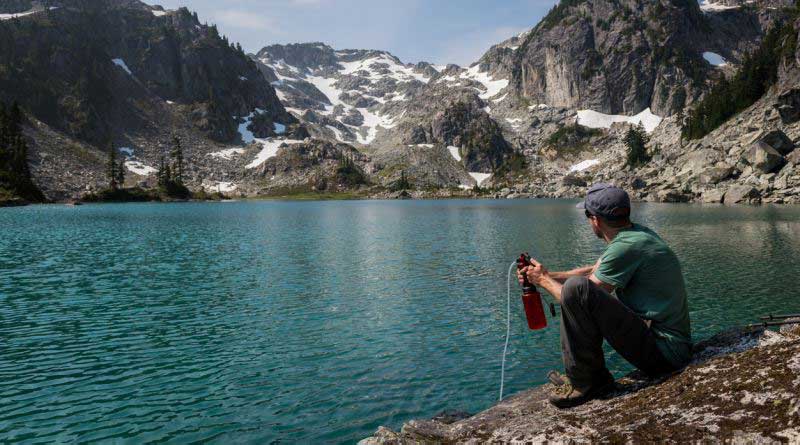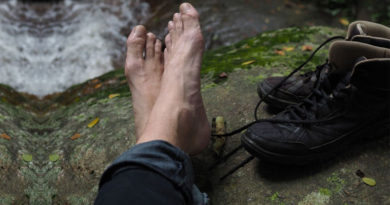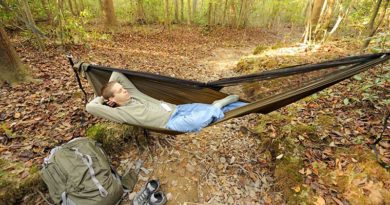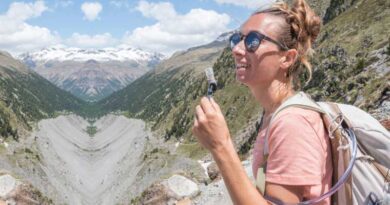4 Easy Ways to Purify Water in the Wilderness
Water is called the source of life because, as we, the common people know it, life cannot exist without water. So it goes without saying that water is essential for human life. After all, two third of the human
There have been thousands of stories of people who got lost in the wild but somehow managed to get back alive because they found water. Humans can go for weeks without food, but a person can’t last more than 3-5 days without clean, drinking water.
Water not only supports human life, but it also supports microscopic life. Water contains billions or even trillions of microbes most of which are harmless but water also contains some of the most harmful microbes that can cause fatal diseases or diseases that can prove fatal when you are in the wild.
This is where water presents two dilemmas for humans.
- Even though we need water to live, water in the wild can also kill us. So we have to be very careful when we drink water from the wild.
- Water is heavy. 1 liter of water weighs more than 2 lbs. This is a problem when you are going on hikes and you need to pack ultralight.
An alternative to this is that you can rely on some sort of water purification system in the wild to help you pack light. This is not to say that you don’t have to bring water with you in the wild. But you can keep just enough water for the way, and even if you do run out, you don’t have to panic. You can purify water from a clean water source that you find in the wild e.g. streams, rivers, etc.
For this, you need to have complete knowledge of the water bodies in the way that you will be hiking so that you can take enough water to get to the next one without running out. When you get to a water source, make sure to drink a lot of water and always keep extra for the weight is worth it.
It is recommended that you use some sort of water purification system in the wild to keep yourself safe from diseases. Most hikers tend to drink straight from streams and rivers and hope for the best. This is not recommended because the consequences can be severe.
Personal hygiene matters because most of the times, water is blamed for dirty water. Keep a hand sanitizer or soap with you and don’t forget to wash your hands before a meal and after taking a toilet break.
How you purify water is a completely personal choice. There are mainly 4 different ways to filter water in the wilderness:
- Boiling
- Water filters
- Chemical purification
- UV light purification
All these purification systems have their up and down sides pertaining to weight, purification time and cost. However, it is recommended to keep a chemical purifier as a backup.
Boiling

Boiling is the easiest way to purify water. All you need is a pot in which you want to boil water. Make sure that the pot itself is clean. Pour water in it and heat it until bubbles start appearing. Keep heating after for 5 minutes after bubble formation and then put away to cool.
It is the most
Boiling water has its limitations and downsides though. First of all, you can only take clean and clear water to boil. Water from unhealthy sources like a stagnant pond with a false odour or water containing dirt and sedimentation will get you sick in the end. Second, boiling water doesn’t get rid of all the microbes. Some microbes are too stubborn to die. Furthermore, boiling water doesn’t kill some spores as well. But still, it kills up to 99.99% microbes and is a very effective technique.
The other downside of boiling water is that it is a tedious and requires time. You can’t purify water on the go and you always need to make a stop. People usually don’t have enough resources, like a gas canister, to boil water so they would have to start a fire in the wild to get it done. In large groups, you would need a large pot to account for everyone.
All these downsides make it unsuitable for large groups. However, it is viable for small groups of 3 to 4 people looking for an overnight trip in the wild.
Water Filters
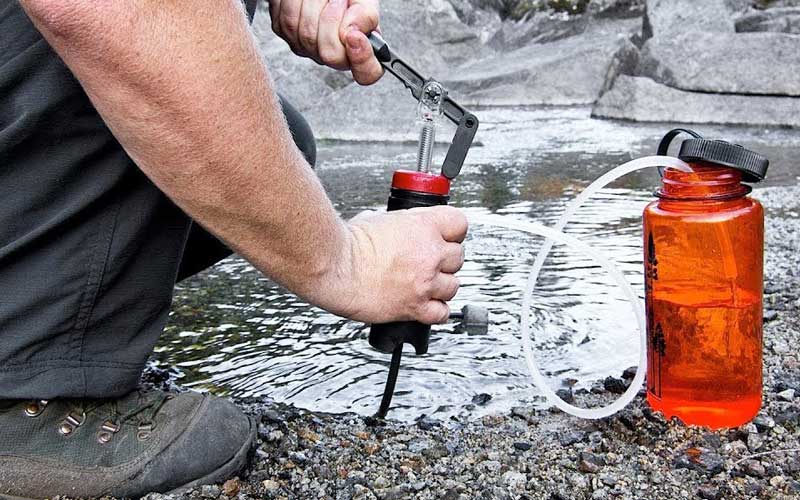
Water filters are a great way to get purified water in the wilderness without boiling. These filters use physical barriers to filter out microbes, particles
They are portable and can keep providing you with water as long as you come across water bodies in the wild. There are different types of water filters on the market like pump filters, gravity filters, filter bottles, etc. All of them have their pros and cons which makes them suitable for large groups or individual use.
The downsides of water filters
- Hand Pumps
- Gravity Filters
One additional downside of both of these types is that they don’t provide you with water on the go. You would have to make a stop. But still, they are great for hikers and have their advantages which are discussed below.
Hand Pumps
As the name implies, it requires you to pump the water from the water source into a bottle or container. Hand pumps are a good choice for individuals or small groups. What makes them so popular is that they are lightweight and easy to use. They provide you with an
Hand pumps can either be basic filters that get rid of sediments and microbes or they can be purifiers that get rid of even viruses and tiny particles. The downside of a hand pump is that the pumping can become tedious and the filters are prone to wear and tear because of the pressure applied. However, you can have hand pumps with high water flow and high durability but you would have to move up the cost to get them.
Gravity Filters
Gravity filters, again, as name suggests, use gravity to filter water. One reason that makes them popular is that it requires no work to get filtered water except that you still have to fill the bag (well duh! The bag won’t fill itself). Gravity does the work for you as you sit back and relax.
Gravity filters are good for large groups. They can filter a large amount of water. However, you don’t get instant supply. You have to wait for gravity to do its work. Gravity filters include two bags one of which is hung at a tall height and the other at a lower height. The water from the upper bag passes through a filter and drops down into the lower bag through tubes.
The upsides of this are that you get clean water without doing anything. However, the downsides of a gravity filter are that they are a solid hit on your wallet and they are heavy to carry and take up a lot of space when it comes to ultralight packing. Usually, gravity filters are carried by large groups who share the weight. Then there is the waiting. Although, certain gravity filters like the Platypus GravityWorks is very fast at an impressive rate of 1.75 liters per minute. Again, you would have to move up in cost.
Chemical Purification
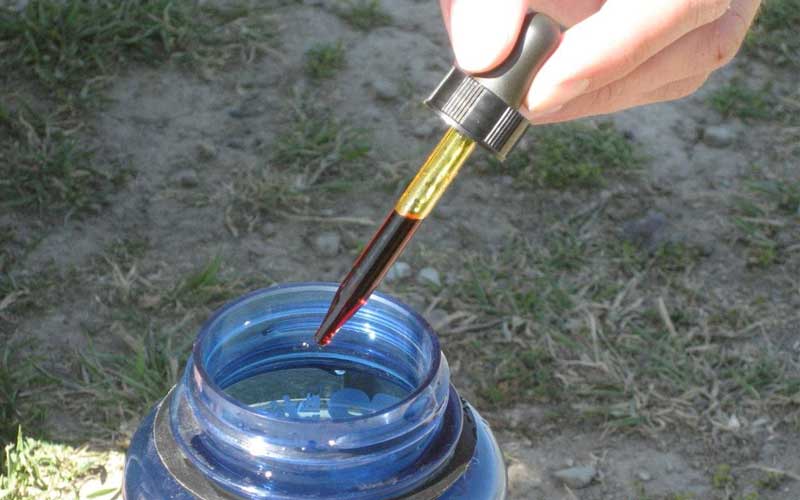
Chemical purification includes, tablets and drops poured in water to disinfect it. Chemicals are super light to carry, don’t take much space and are also not expensive to buy, The chemicals used for purifying water mostly include chlorine dioxide and iodine. Although, sometimes bleach is used as well. Remember, it is only recommended as emergency use.
Besides being an extremely lightweight and low-cost option, there are a lot of downsides of chemicals. To begin with, they are chemicals, and they are harmful to the body. The second is that they leave a bad taste in the water, an issue that is reported more with iodine and bleach and less with chlorine dioxide but is nevertheless there. There are taste neutralizers to get rid of the taste but they are more chemicals.
One other thing about chemical purification is that water would still be unfiltered. So you would definitely have to choose a drinking source like a running stream so that you don’t get any sedimentation in it. However, chemicals are popular with hikers because as it is mentioned, they are an ultralight,
UV Light Purification
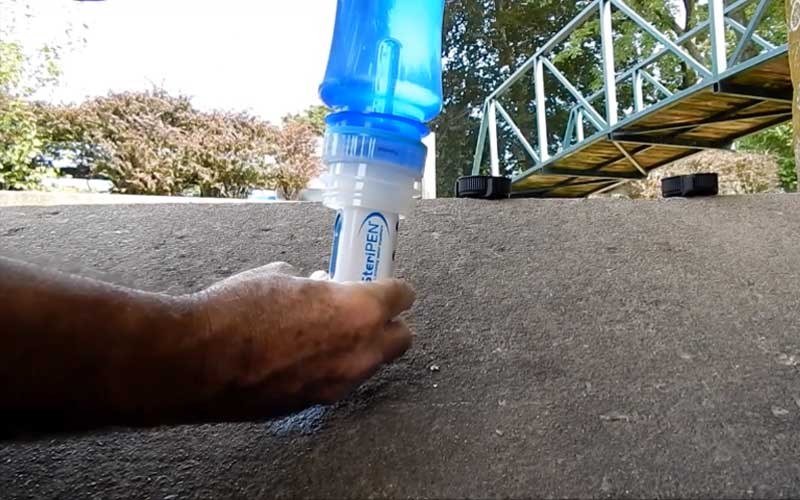
The UV light is high-frequency light rays that have high penetration ability. The
The UV light is another good extremely lightweight option for hikers and it is to store and travel with. A burst of ultraviolet light is all you need to purify water. You get to have pure drinking water on the go and the waiting time is as little as 60 seconds.
There are some disadvantages of using a UV light. First, it is only suitable for individual use with low quantity. Prolonged use is not an option. Also UV light doesn’t work well in murky water.
The water is not filtered so you have to choose a good source of water. Another most annoying thing about the UV light treatment is the insecurity it brings. There is this insecurity whether you are doing it right, whether you should dip it more, or dip it less or should you dip it for some more time or whether it has done anything or that now is it safe to drink. There is just no way to confirm this.
With UV lights you also have to be cautious because they are hazardous to human body and can cause burns and even cancer. So be very careful and keep it strictly out of children’s reach. The last thing about UV light is the price. They are expensive, and being battery powered, extra batteries add to that cost.
Conclusion
In the end, your purification method is your personal choice. Usually hikers go for a combination of purification methods to ensure utmost safety. The extra weight and cost are worth it because water is essential yet, it brings danger with it. Developing a disease in the wild can be fatal due to lack of proper medical resources and sometimes, you are too far away from city or medical facilities that you might not make it in time.
So ensure your safety and stay safe out there!

